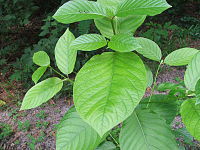
Photo from wikipedia
Kratom (Mitragyna speciosa Korth) has been used traditionally in Southeast Asia for its therapeutic properties. The major alkaloid of kratom, mitragynine, binds to opioid receptors to give opioid‐like effects that… Click to show full abstract
Kratom (Mitragyna speciosa Korth) has been used traditionally in Southeast Asia for its therapeutic properties. The major alkaloid of kratom, mitragynine, binds to opioid receptors to give opioid‐like effects that causes addiction. In our previous study, we have identified AZ122 as a unique biomarker in habitual or regular kratom users through analysis of their urinary protein profiles. We aimed to develop and validate a screening method by means of enzyme‐linked immunosorbent assay (ELISA) for detection of kratom habitual users. An ELISA approach was applied for the development of a screening method using urinary AZ122 as biomarker. Method validation was carried out using three quality control materials at different concentration of AZ122. The data was analyzed statistically using SPSS (Version 25). The ELISA was presented with Pearson correlation coefficient of 0.9993. The repeatability and reproducibility were presented at CV <7%, while the accuracy ranged from 78 to 96% at various AZ112 concentrations. Upon testing on 176 male respondents (n = 88 regular kratom users and n = 88 healthy controls), the specificity and sensitivity of the assay were both 100%. The ELISA has been validated and can be potentially used as a reliable screening test for detection of kratom habitual users.
Journal Title: Biotechnology and Applied Biochemistry
Year Published: 2022
Link to full text (if available)
Share on Social Media: Sign Up to like & get
recommendations!